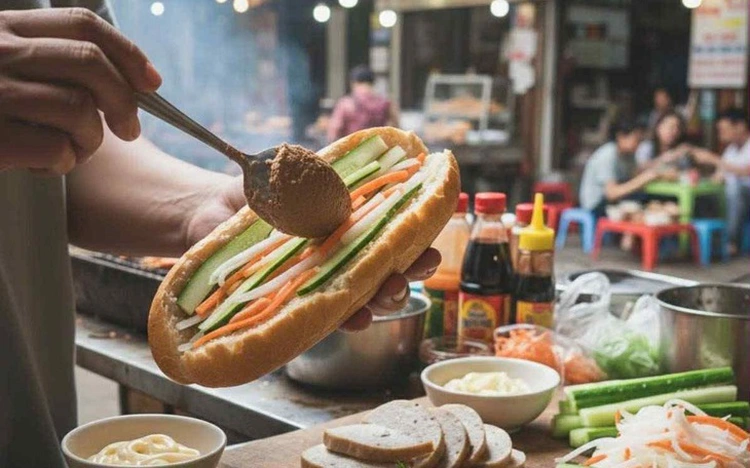
A vendor is seen filling a 'banh mi' with various ingredients. Photo: AI
The latest outbreak, which broke out on Thursday last week, had led to the hospitalization of 235 people as of Monday morning, including one severe case, according to the Ho Chi Minh City Department of Health.
Salmonella bacteria are believed to be the main cause, consistent with previous ‘banh mi’-related incidents.
Experts note that contamination usually comes from the fillings rather than the bread itself.
Nguyen Duy Thinh, a former expert at the Institute of Food Science and Technology under the Hanoi University of Science and Technology, explained that ingredients such as ‘cha lua’ (Vietnamese pork roll), pâté, sausages, cucumbers, chili sauce, and raw vegetables are particularly susceptible to bacterial contamination.
Pâté poses the highest risk because it is made from steamed liver and pork fat, a process that may not fully eliminate bacteria.
If the pâté is not stored properly, these bacteria can multiply rapidly, and even reheating contaminated foods may not remove the toxins already produced.
Dr. Do Van Dung of the University of Medicine and Pharmacy at Ho Chi Minh City noted that large-scale ‘banh mi’ shops face higher risks because they use multiple ingredients, many of which are cold-processed and not reheated before serving.
Manual preparation and weak quality control further increase hygiene risks, especially in hot weather, making improper storage and handling a key factor in repeated contamination.
Gastroenterologist Vo Dang Toan explained that typical Salmonella infection symptoms include diarrhea, fever, abdominal cramps, and nausea, lasting several days to a week.
While most healthy individuals recover with proper treatment, vulnerable groups such as children and the elderly can experience severe complications, including septic shock or kidney failure.
Nguyen Trung Nguyen, director of the Poison Control Center at Bach Mai Hospital, added that about eight percent of Salmonella cases can lead to bloodstream infections or septic shock, highlighting the urgent need for strict prevention measures.
To curb future outbreaks, experts stress that producers and vendors must take greater responsibility for food safety, ensuring proper handling, storage, and preparation of all ingredients.
The Vietnam Food Administration (VFA) under the Ministry of Health said it is drafting new food safety guidelines for street vendors and collective kitchens, covering ingredient selection, storage, contamination prevention, and handling procedures for suspected food poisoning cases.
The VFA has also instructed local authorities to strengthen inspections, trace contaminated ingredients, and strictly enforce regulations to ensure compliance.
Large ‘banh mi’ brand holders emphasized the importance of proper cold-chain logistics.
Perishable fillings such as pâté, cold cuts, and sausages should be transported in refrigerated vehicles and discarded if unsold by the end of the day.
Vendors must also ensure that all ingredients have clear origins and defined usage periods to minimize the risk of contamination.
Truong Binh, owner of a local ‘banh mi’ brand, said his company produces pâté in-house, stores it frozen, and uses it within a day, while sourcing other fillings from reputable suppliers.
However, he cautioned that many small vendors still cut corners to save costs, buying cheap ingredients of uncertain origin and storing them improperly, which increases the risk of contamination.
Experts stressed that preventing food poisoning from ‘banh mi’ requires vigilance at every stage from ingredient sourcing and production to storage and sale.
Only through strict compliance with food safety standards and consistent enforcement can future outbreaks be prevented and public health protected.


Max: 1500 characters
There are no comments yet. Be the first to comment.